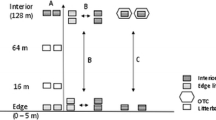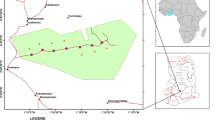Abstract
This study investigated how forest soil acidification is affected by edge proximity. We measured pH(KCl) and exchangeable K, Ca, Mg and Al concentrations of the mineral topsoil (0–30 cm) from the exposed edge to the interior (128 m from the edge) of three deciduous and four coniferous forest stands. From the front edge to the interior of the deciduous stands, the pH(KCl) values decreased at 0–5 cm soil depth (from 3.07 to 2.98) but increased at 5–10 cm (from 3.26 to 3.32) and 10–30 cm (from 3.48 to 3.75) depth. In the coniferous stands, pH(KCl) values declined from edge to interior at all soil depths, i.e. from 3.10 to 2.89, from 3.26 to 3.06 and from 3.54 to 3.31 at 0–5, 5–10 and 10–30 cm, respectively. The concentrations of exchangeable cations decreased from edge to interior, with larger differences in the coniferous (of up to 265 %) than in the deciduous stands (up to 99 %). At forest edges, enhanced soil acidification due to higher potentially acidifying deposition could be counteracted in the upper mineral soil by higher base cation throughfall and litterfall, faster litter decomposition, higher soil organic matter content, lower nitrate leaching from the soil and/or lime fertiliser drift. Nonetheless, deeper in the soil of the deciduous stands, these buffer processes seem unable to counteract soil acidification due to potentially acidifying deposition at the edges. Edge effects on soil acidity are important since they can translate into effects on plant communities, soil biota, nitrogen cycling and carbon sequestration.





Similar content being viewed by others
References
Augusto, L., Ranger, J., Binkley, D., & Rothe, A. (2002). Impact of several common tree species of European temperate forests on soil fertility. Annals of Forest Science, 59, 233–253.
Augusto, L., Dupouey, J.-L., & Ranger, J. (2003). Effects of tree species on understory vegetation and environmental conditions in temperate forests. Annals of Forest Science, 60, 823–831.
Balsberg-Påhlsson, A.-M., & Bergkvist, B. (1995). Acid deposition and soil acidification at a southwest facing edge of Norway spruce and European beech in south Sweden. Ecological Bulletins, 44, 43–53.
Blaser, P., Walthert, L., Zimmermann, S., Graf Pannatier, E., & Luster, J. (2008). Classification schemes for the acidity, base saturation, and acidification status of forest soils in Switzerland. Journal of Plant Nutrition and Soil Science, 171, 163–170.
Bowering, M., LeMay, V., & Marshall, P. (2006). Effects of forest roads on the growth of adjacent Lodgepole pine trees. Canadian Journal of Forest Research, 36, 919–929.
Bowman, W. D., Cleveland, C. C., Halada, L., Hreško, J., & Baron, J. S. (2008). Negative impact of nitrogen deposition on soil buffering capacity. Nature Geoscience, 1, 767–770.
Bredemeier, M. (1989). Nature and potential of ecosystem-internal acidification processes in relation to acid deposition. In J. W. S. Longhurst (Ed.), Acid deposition (pp. 197–212). London: British Library Technical Communications.
De Schrijver, A. (2007). Acidification and eutrophication of forests on sandy soil: effects of forest type and deposition load. Ph.D. thesis, Ghent: Ghent University, 189p.
De Schrijver, A., Nachtergale, L., Roskams, P., De Keersmaeker, L., Mussche, S., & Lust, N. (1998). Soil acidification along an ammonium deposition gradient in a Corsican pine stand in northern Belgium. Environmental Pollution, 102(S1), 427–431.
De Schrijver, A., Mertens, J., Geudens, G., Staelens, J., Campforts, E., Luyssaert, S., et al. (2006). Acidification of forested podzols in North Belgium during the period 1950–2000. Science of the Total Environment, 361, 189–195.
De Schrijver, A., Devlaeminck, R., Mertens, J., Wuyts, K., Hermy, M., & Verheyen, K. (2007a). On the importance of incorporating forest edge deposition for evaluating exceedance of critical pollutant loads. Applied Vegetation Science, 10(2), 293–298.
De Schrijver, A., Geudens, G., Augusto, L., Staelens, J., Mertens, J., Wuyts, K., et al. (2007b). The effect of forest type on throughfall deposition and seepage flux: a review. Oecologia, 153, 663–674.
De Schrijver, A., Staelens, J., Wuyts, K., Van Hoydonck, G., Janssen, N., Mertens, J., et al. (2008). Effect of vegetation type on throughfall deposition and seepage flux. Environmental Pollution, 153, 295–303.
De Schrijver, A., De Frenne, P., Staelens, J., Verstraeten, G., Muys, B., Vesterdal, L., et al. (2012). Tree species traits cause divergence in soil acidification during four decades of postagricultural forest development. Global Change Biology, 18, 1127–1140.
Devlaeminck, R., De Schrijver, A., & Hermy, M. (2005). Variation in throughfall deposition across a deciduous beech (Fagus sylvatica L.) forest edge in Flanders. Science of the Total Environment, 337(1–3), 241–252.
Draaijers, G. P. J., van Ek, R., & Bleuten, W. (1994). Atmospheric deposition in complex forest landscapes. Boundary-Layer Meteorology, 69, 343–366.
Driscoll, C. T., Lawrence, G. B., Bulger, A. J., Butler, T. J., Cronan, C. S., Eagar, C., et al. (2001). Acidic deposition in the Northeastern United States: sources and inputs, ecosystem effects, and management strategies. BioScience, 51, 180–198.
FAO-ISRIC-ISSS (1998). World reference base for soil resources. World Soil Resources Report 84. Rome: FAO.
Frainer, A., & Duarte, M. M. (2009). Soil invertebrates in southern Brazilian Araucaria forest—grassland mosaic: differences between disturbed and undisturbed areas. Iheringia Série Zoologia, 99, 307–312.
Ge, Y., & Hendershot, W. (2004). Evaluation of soil surface charge using the back-titration technique. Soil Science Society of America Journal, 68, 82–88.
Hagen-Thorn, A., Callesen, I., Armolaitis, K., & Nihlgård, B. (2004). The impact of six European tree species on the chemistry of mineral topsoil in forest plantations on former agricultural land. Forest Ecology and Management, 195, 373–384.
Hasselrot, B., & Grennfelt, P. (1987). Deposition of air pollutants in a wind-exposed forest edge. Water, Air, and Soil Pollution, 34,135–143.
Hobbie, S., Reich, P. B., Oleksyn, J., Ogdahl, M., Zytkowiak, R., Hale, C., et al. (2006). Tree species effects on decomposition and forest floor dynamics in a common garden. Ecology, 87, 2288–2297.
Honnay, O., Verheyen, K., & Hermy, M. (2002). Permeability of ancient forest edges for weedy plant species invasion. Forest Ecology and Management, 161(1–3), 109–122.
Jabin, M., Mohr, D., Kappes, H., & Topp, W. (2004). Influence of deadwood on density of soil macro-arthropods in a managed oak–beech forest. Forest Ecology and Management, 194, 61–69.
Kreutzer, K., Beier, C., Bredemeier, M., Blanck, K., Cummins, T., Farrell, E. P., et al. (1998). Atmospheric deposition and soil acidification in five coniferous forest ecosystems: a comparison of the control plots of the EXMAN sites. Forest Ecology and Management, 101, 125–142.
Laverman, A. M., Zoomer, H. R., Engelbrecht, D., Berg, M. P., van Straalen, N. M., van Verseveld, H. W., et al. (2000). Soil layer-specific variability in net nitrification and denitrification in an acid coniferous forest. Biology and Fertility of Soils, 32, 427–434.
Lofts, S., Woof, C., Tipping, E., Clarke, N., & Mulder, J. (2001). Modelling pH buffering and aluminium solubility in European forest soils. European Journal of Soil Science, 52, 189–204.
Malmivaara-Lämsä, M., Hamberg, L., Haapamäki, E., Liski, J., Kotze, D. J., Lehvävirta, S., et al. (2008). Edge effects and trampling in boreal urban forest fragments—impacts on the soil microbial community. Soil Biology and Biochemistry, 40, 1612–1621.
McDonald, R. I., & Urban, D. L. (2004). Forest edges and tree growth rates in the North Carolina Piedmont. Ecology, 85(8), 2258–2266.
Persson, T., & Wirén, A. (1995). Nitrogen mineralisation and potential nitrification at different depths in acid forest soils. Plant and Soil, 168–169, 55–65.
Pinheiro J., Bates D., DebRoy S., Sarkar D., & R Development Core Team (2010). nlme: linear and nonlinear mixed effects models. R package version 3.1-97. http://cran.r-project.org/package=nlme.
R Development Core Team. (2009). R: a language and environment for statistical computing. Vienna: R Foundation for Statistical Computing. http://www.R-project.org.
Reich, P. B., Oleksyn, J., Modrzynski, J., Mrozinski, P., Hobbie, S. E., Eissenstat, D. M., et al. (2005). Linking litter calcium, earthworms and soil properties: a common garden test with 14 tree species. Ecology Letters, 8, 811–818.
Sherich, K., Pocewicz, A., & Morgan, P. (2007). Canopy characteristics and growth rates of ponderosa pine and Douglas-fir at long-established forest edges. Canadian Journal of Forest Research, 37, 2096–2105.
Skyllberg, U. (1999). pH and solubility of aluminium in acidic forest soils: a consequence of reactions between organic acidity and aluminium alkalinity. European Journal of Soil Science, 50, 95–106.
Spangenberg, A., & Kölling, C. (2004). Nitrogen deposition and nitrate leaching at forest edges exposed to high ammonia emissions in Southern Bavaria. Water, Air, and Soil Pollution, 152(1–4), 233–255.
Szibalski, M., & Felix-Henningsen, P. (1999). Gradienten von Bodeneigenschaften im Randbereich kleinflächiger Waldstandorte des östlichen Münsterlandes—Gradients of soil characteristics at fringe areas of small forest habitats of the Eastern Münsterland. Journal of Plant Nutrition and Soil Science, 162, 49–55.
Ulrich, B. (1990). An ecosystem approach to soil acidification. In B. Ulrich & M. E. Sumner (Eds.), Soil acidity (pp. 28–79). Berlin: Springer.
van Breemen, N., Driscoll, C. T., & Mulder, J. (1984). Acidic deposition and internal proton sources in acidification of soils and waters. Nature, 307, 599–604.
Van Ranst, E., De Coninck, F., Roskams, P., & Vindevogel, N. (2002). Acid-neutralizing capacity of forest floor and mineral topsoil in Flemish forests (North Belgium). Forest Ecology and Management, 166, 45–53.
Vasconcelos, H. L., & Luizão, F. J. (2004). Litter production and litter nutrient concentrations in a fragmented Amazonian landscape. Ecological Applications, 14, 884–892.
Verstraeten, A., Sioen, G., Neirynck, J., Corluy, J., Dhaluin, P., De Geest, L., Smesman, E., Coenen, S., Roskams, P., Hens, M. (2010). Bosgezondheid in Vlaanderen : bosvitaliteitsinventaris, meetnet Intensieve Monitoring Bosecosystemen en meetstation luchtverontreiniging. Resultaten 2008–2009 [in Dutch: Conditions of forests in Flanders: forest vitality inventory, measuring network Intensive Monitoring of Forest Ecosystems and measuring station air pollution]. Brussels: Research Institute for Nature and Forest.
Vervaet, H., Massart, B., Boeckx, P., Van Cleemput, O., & Hofman, G. (2002). Use of principal component analysis to assess factors controlling net N mineralization in deciduous and coniferous forest soils. Biology and Fertility of Soils, 36, 93–101.
Wuyts, K., De Schrijver, A., Staelens, J., Gielis, L., Geudens, G., & Verheyen, K. (2008a). Patterns of throughfall deposition along a transect in forest edges of silver birch and Corsican pine. Canadian Journal of Forest Research, 38, 449–461.
Wuyts, K., De Schrijver, A., Staelens, J., Gielis, L., Vandenbruwane, J., & Verheyen, K. (2008b). Comparison of forest edge effects on throughfall deposition in different forest types. Environmental Pollution, 156, 854–861.
Wuyts, K., De Schrijver, A., Staelens, J., Van Nevel, L., Adriaenssens, S., & Verheyen, K. (2011). Soil inorganic N leaching in edges of different forest types subject to high N deposition loads. Ecosystems, 14, 818–834.
Acknowledgments
The authors greatly acknowledge the field and lab assistance by Luc Willems and Greet De bruyn and the statistical support by Lander Baeten. KW was funded by the Special Research Fund of Ghent University (BOF) and the Agency for Innovation by Science and Technology (IWT, Vlaanderen), ADS and JS were supported as postdoctoral fellows by the Research Foundation—Flanders (FWO, Vlaanderen). We would like to thank the Agency for Nature and Forest and the private forest owners and their ground keepers for allowing access to their forests. We appreciate the valuable suggestions provided by the reviewers.
Author information
Authors and Affiliations
Corresponding author
Rights and permissions
About this article
Cite this article
Wuyts, K., De Schrijver, A., Staelens, J. et al. Edge Effects on Soil Acidification in Forests on Sandy Soils Under High Deposition Load. Water Air Soil Pollut 224, 1545 (2013). https://doi.org/10.1007/s11270-013-1545-x
Received:
Accepted:
Published:
DOI: https://doi.org/10.1007/s11270-013-1545-x




